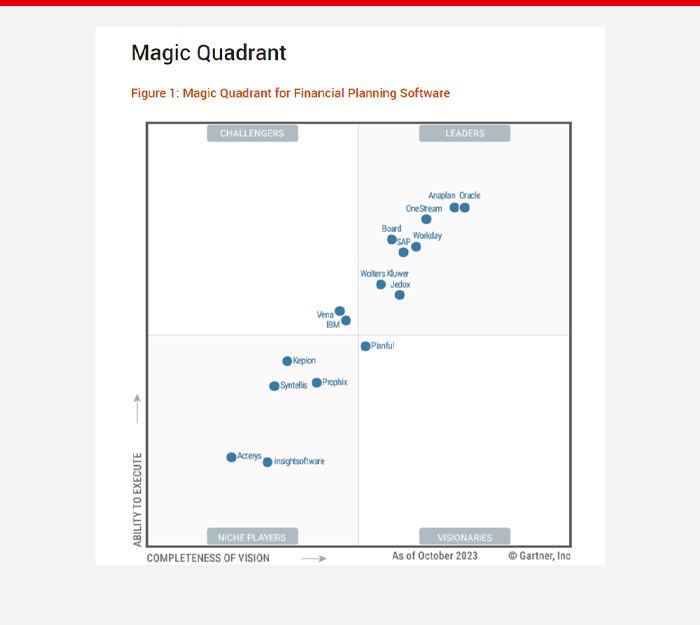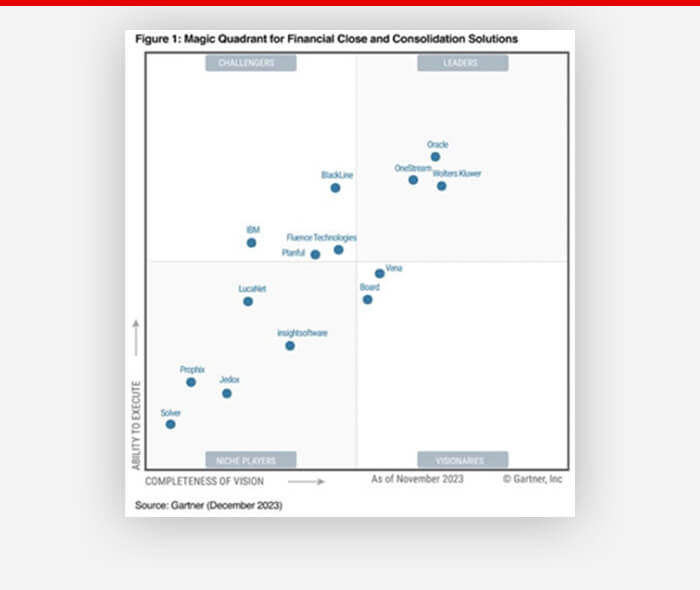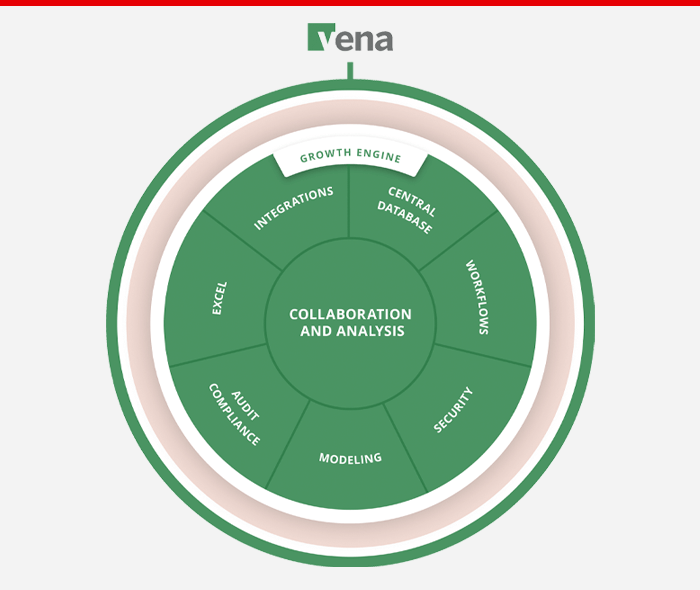How Vena Solutions compares to common alternatives
Challenges
- Accelerate budgeting cycles with streamlined workflows
- Unify disconnected data sources for seamless financial analysis
- Enhance forecasting accuracy
Tools don’t solve problems; they make processes run more smoothly. Business processes should be supported by the right software. TriFinance assists companies in choosing the application that is right for them.
Comparing Vena with other EPM Tools to find the right fit
TriFinance is tool-agnostic by design, meaning we always focus on finding the best solutions for our client's specific needs. For EPM, however, we have a strategic partnership with Vena Solutions because we believe in Vena Solutions’ deep integration with the Microsoft stack. To maximize Microsoft technology investments, Vena Solutions strategically integrates with Microsoft Excel, PowerPoint, Power Bi, Teams, Copilot, etc.
While we value Vena's strengths, we also recognize the wide range of EPM alternatives available. This page compares Vena Solutions with other common options, helping you choose the right EPM tool for your needs.
TriFinance assists companies in choosing the application that is right for them.
Why Vena Solutions?
Vena Solutions (www.venasolutions.com) is a good choice for organizations looking to streamline and professionalize their Financial Planning & Analysis (FP&A) and reporting processes.
Vena’s deep integration with Microsoft Excel, Microsoft 365, and Power BI allows users to work in a familiar environment while leveraging advanced features like centralized data storage, workflows, and enhanced auditability.
Vena Solutions is a prominent player in the EPM software industry. Its standout feature is its Excel-based platform that supports financial reporting, sales performance management, financial close, and ESG reporting.
As a recognized "Challenger" in the Gartner Magic Quadrant for Financial Planning software, Vena delivers robust solutions for budgeting, financial reporting, and ESG reporting. Vena is also recognized as a "Visionary" in the Magic Quadrant for Financial Close and Consolidation Software.
TriFinance’s certified Vena consultants help organizations optimize their FP&A processes and tailor the software to their specific needs.


Key Capabilities and Differentiators of Vena Solutions
The following capabilities truly differentiate Vena from alternative EPM solutions:
- Excel Integration: Vena Excel Integration: Most FP&A professionals rely on Excel for their planning process. Instead of eliminating Excel, Vena will leverage the familiarity and flexibility of Excel. Users can continue working in the familiar Excel environment while benefiting from improved data management and automation. This approach reduces the learning curve and boosts user adoption.
- Powerpoint Integration:In addition to Excel, Vena integrates with Microsoft PowerPoint to automate FP&A and reporting presentations. This boosts productivity and efficiency, as presentations are directly linked to the Vena data model and automatically update with real-time data changes.
- Vena Copilot: Vena Copilot serves as an FP&A assistant for non-financial users. Built on Azure OpenAI, it utilizes a specialized Large Language Model designed specifically for budgeting and forecasting, making financial processes more accessible and intuitive for all users.
- Project Length: Vena ranks first in the BARC Planning Survey for its implementation speed. With Vena, you can start small projects and scale up when needed, so you get fast results.
- Price to value: Vena offers a more modest licensing cost compared to many competitors, earning recognition as a leader in the BARC Planning Survey for its price-to-value ratio. Pricing is based on a platform fee and a user-based pricing model, depending on the type of user. This makes Vena a highly scalable and cost-effective solution for organizations of all sizes.
- Ease of use: Not only for end users but also for key users, Vena offers a user friendly interface. Since input templates and reports are built in Excel, key users will leverage their existing Excel knowledge to build a planning solution in Vena. This lowers the learning curve and makes sure you can be self-sufficient.
- Cloud-Based Platform: As a cloud-based solution, Vena offers scalability, remote accessibility, and lower total cost of ownership. The cloud infrastructure ensures that data is always up-to-date and accessible from anywhere. It’s scalability makes it suitable for organizations of all sizes.
- Collaboration and Workflow Automation: Vena’s workflow and collaboration features are no code solutions. They make it very easy to streamline communication and approval processes. This improves efficiency and ensures that all stakeholders are aligned and informed.

Three EPM tools compared with Vena Solutions
- Board International
Overview:
Board International offers an all-in-one decision-making platform that integrates business intelligence (BI), EPM, and analytics. Board International is recognized as a Leader in the Gartner Magic Quadrant for Financial Planning Software and as a Visionary in the Gartner Magic Quadrant for Financial Close and Consolidation Software.
Strengths:
Board International seamlessly combines EPM capabilities with BI features, offering a versatile solution for various corporate functions. Key features include:- Intuitive, customizable interface: The user interface is designed to be highly intuitive and can be easily tailored to specific needs, making it accessible to users at all levels.
- Dynamic Microsoft Office integration: Board integrates in real time with Microsoft Office, keeping data dynamic and up-to-date..
- Effortless model setup for key functions: Budgeting, planning, and reporting models are straightforward to configure—requiring no coding skills.
Limitations:
Using Board for sophisticated budgeting, forecasting, and reporting tasks can require significant effort, particularly in scenarios that demand fully driver-based planning. For example:- Driver-based sales processes: Automatically populate the P&L based on sales drivers.
- Investment and CAPEX planning: Link directly to both balance sheets and P&L statements.
- Workforce Planning: Distribute resources across various cost centers and departments seamlessly.
It’s also worth noting that while Board’s core strengths lie in Business Intelligence (BI), it lacks a dedicated consolidation engine, which can make certain consolidation tasks less straightforward compared to specialized tools. According to BARC, the price-to-value ratio of Board is below average, which is another consideration for stakeholders evaluating return on investment. - Jedox
Overview:
Jedox is a software platform that combines Enterprise Performance Management (EPM) and Business Intelligence (BI) capabilities, designed to help organizations streamline their budgeting, forecasting, and reporting processes. Built to enhance financial planning and analysis activities, Jedox provides tools for data modeling, analytics, and reporting—all within a highly customizable environment.
Strengths:- Excel-like interface for ease of use: Jedox offers an interface familiar to Excel users, promoting fast adoption and reducing the need for extensive training.
- Automated, multi-dimensional modeling intelligence: When loading customer Excel files, Jedox converts them into multi-dimensional models, streamlining complex data setup.
- Dual interface options (Web and Excel): Users can seamlessly switch between a web-based interface and Excel, allowing flexibility in how they access and work with data.
- High-performance in-memory calculations: Jedox's in-memory engine supports powerful, rapid calculations, even for complex data sets, ensuring timely insights.
- Extensive APIs and out-of-the-box connectors: Jedox integrates easily with many source systems, including SAP and Microsoft Dynamics, and provides connectors for seamless integration with BI tools like Power BI, QlikView, and Qlik Sense.
- Marketplace for models and solutions: Jedox’s marketplace allows partners and customers to share pre-built models and solutions, accelerating deployment and enhancing collaboration.
While Jedox offers powerful modeling capabilities, certain aspects can be challenging:- Complex coding requirements: In-depth coding is sometimes needed for advanced modeling, which can make the tool less accessible and intuitive for non-technical users.
- Manual report and dashboard setup: Creating reports and dashboards often involves substantial manual configuration and upkeep, which can slow down implementation and require ongoing maintenance.
- Cumbersome security configuration: Setting up security protocols can be complex, adding an extra layer of effort for administrators to manage data access and permissions effectively.
- IBM Planning Analytics , IBM Cognos Controller and IBM Cognos Analytics
Overview:
IBM Planning Analitycs (IBM PA)
IBM Cognos Controller ( IBM CC)
IBM Cognos Analytics (IBM CA)
IBM offers a full suite of software applications to set-up an integrated Enterprise Performance Platform for planning, budgeting, management reporting, consolidation and BI. The software applications are complemented with strong AI functionalities powered by Watson
Strengths :- Integrated best-of-breed software: IBM’s platform combines leading functionalities across planning, budgeting, reporting, and consolidation. The planning, budgeting, and reporting tools leverage Online analytical processing (OLAP) technology, while consolidation and BI functions use relational database technology for robust performance.
- Unified data structure with embedded cubes: IBM integrates all components using embedded cubes to integrate consolidated data with analytical insights, while unifying all master data within cubes for easy access in BI processes.
- Seamless data access for end-users: The Excel integration offers easy data access, while the web interface allows for rapid deployment of data input/output templates, improving accessibility and ease of use for end-users.
- Generative AI capabilities: IBM’s generative AI functionalities enhance both data analysis and the development of analytical models, providing advanced tools for predictive insights and model creation.
- Flexible deployment options: Available as both a cloud-based and on-premises solution, IBM’s offering provides flexibility to fit diverse IT environments.
- Pricing: The platform is competitively priced, often coming in below the market average.
- Market perception of aging technology: IBM’s solutions—Planning Analytics (PA), Cognos Controller (CC), and Cognos Analytics (CA)—are often viewed as outdated. This perception can hinder adoption among users who are exploring more modern alternatives.
- Complexity in setup and maintenance: The implementation and ongoing maintenance of planning and analytical reporting can be intricate, typically requiring skilled technical expertise to navigate the complexities effectively.
- Performance dependency on developer skill: The efficiency and performance of IBM's analytical cubes are heavily influenced by the developer's expertise. This dependency can pose challenges for less-experienced teams striving for optimal performance.
- Limited availability of support partners: Although IBM has a global presence, the number of partners that support its technology can be limited. This restriction may impact organizations seeking additional resources or expertise for implementation and support.


Related content
-
Blog
5 reasons why TriFinance is the perfect EPM partner for your organization
-
Article
Expanding Enterprise Performance Management across the company
-
Article
The key to Finance Transformation: Simplicity and agility. A roundtable with TriFinance experts
-
Blog
Overcoming key hurdles in Finance Transformation: a guide for CFOs and Finance teams
-
Reference case
Contributing to finance transformation at VF Europe with temporary bookkeeping support
-
Reference case
Transforming Finance in EMEA for a specialty chemicals company
-
Career in Internal Team
Client Partner | Public Sector
-
Career as Consultant
Senior Finance consultant | Public sector
-
Career as Consultant
Junior Finance Consultant | Public Sector
-
Career as Consultant
Medior Finance Consultant | Public Sector
-
Career in Internal Team
Insurance expert manager
-
Career as Consultant
Young Graduate | Trainee Program